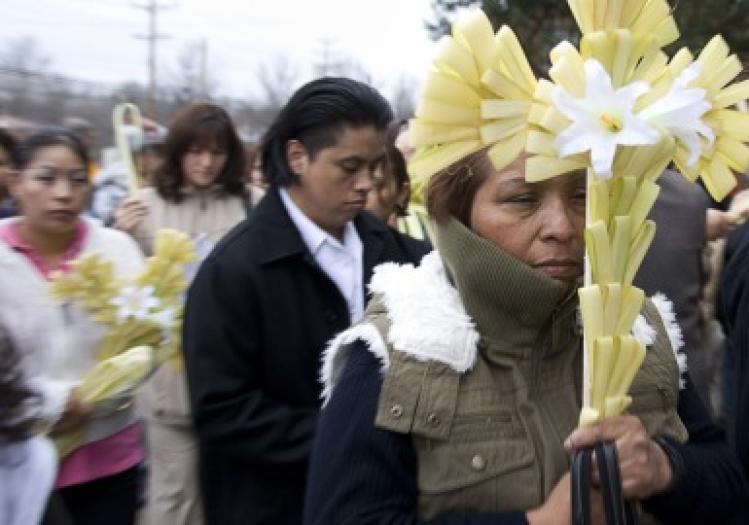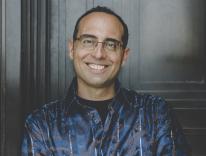
At the height of the 2012 presidential campaign, the dashing Mexican actor Eduardo Verástegui appeared in a series of web videos aimed at Latino Catholics in battleground states. “Our values today are under attack by President Barack Obama,” intoned Verástegui, who starred in Bella, a film with a prolife message. “He is working hard to promote unlimited abortion and undermine traditional marriage. He has unleashed an unprecedented attack on the church and its freedom.” The camera then cut to a close-up of a statue of the Virgin Mary, a tear rolling down her cheek.
Obama, meanwhile, was working the same demographic. Last October, just weeks before Election Day, the president unveiled the César Chávez National Monument at Nuestra Señora Reina de La Paz in Keene, California, where Chávez is buried. Dedicating the site, Obama concluded his remarks with a prayer Chávez wrote for farm workers: “Help us to love even those who hate, so we can change the world.”
These competing appeals signaled the arrival of Latinos—and Latino Catholics in particular—as a pivotal force in American politics. In the election Obama won three-quarters of the Latino Catholic vote, countering Romney’s strength among white Catholics and helping the president push to victory in a string of closely contested states. Indeed, Latino Catholics went for Obama so overwhelmingly that he won the total Catholic vote. The “Catholic Moment” identified by Richard John Neuhaus in 1987 may have come and gone, but it seems that a new, Latino Catholic moment is on the way.
What this moment will mean for the identity of the Catholic Church in the United States—and its civic influence—is hard to say. Though Latino Catholics broke heavily for Obama, it would be a mistake for liberals to be complacent about their political affiliation. While recent data challenge the assumption that most Latino Catholics are socially conservative—a Pew survey found that a plurality of churchgoing Latino Catholics favored legalizing same-sex marriage—polls also show that Latino Catholics with a conservative ideology tend to vote Democratic more than other conservatives. “Hispanics are already Republicans; they just don’t know it yet,” Reagan himself reportedly once quipped.
Whichever way Latino Catholics go, they will likely take the Catholic vote with them. “It is fairly dramatic how the ratio of white Catholics to Hispanic Catholics has shifted really since the early 1990s,” says Robert Jones of the Public Religion Research Institute. Jones notes that a five-to-one ratio among Catholic voters in the 1992 election narrowed to a two-to-one ratio in 2012—“a fairly big sea change,” he says, “in a short amount of time.” This mirrors changes within the church. In American Grace: How Religion Divides and Unites Us, social scientists David Campbell and Robert Putnam point out that nearly three out of every five Catholics aged eighteen to thirty-four—and two out of every three regular churchgoers—are Latino. And “Anglo” Catholics are leaving the church at twice the rate of Latino Catholics.
Where will these trends—along with continued immigration—lead American Catholicism? The short term will likely see a shift to the left on politics, especially regarding social welfare and economic issues. For example, Putnam and Campbell found a sharp contrast between white and Latino Catholics on the question of government aid to the poor: some 40 percent of white Catholics supported spending more, compared to 87 percent of Latino Catholics. A 2006 Pew survey found that churchgoing Latino Catholics were much more likely to consider themselves liberal than white Catholics were (26 percent to 11 percent). As Latinos become dominant in the U.S. Catholic Church, they could bring with them a stronger interest in social-justice activism.
At the same time, Putnam and Campbell found that Latino Catholics have a more orthodox perspective on social issues such as abortion, divorce, and birth control, and that they are less likely than white Catholics to support married priests or the ordination of women. Latino Catholics are more likely to express confidence in the Catholic hierarchy, and to believe that one must agree with the pope on abortion and birth control in order to be a good Catholic. Carlos Vargas-Ramos, co-editor of Blessing La Politica: The Latino Religious Experience and Political Engagement in the United States, traces this apparent conservatism to the 38 percent of Latino Catholics who see themselves as born-again or charismatic. “They are the most faithful of the faithful,” he says, noting that they are more likely than other Latino Catholics to be persuaded by religious-liberty or prolife arguments.
And yet—Eduardo Verástegui’s efforts notwithstanding—Latinos did not vote on social issues in 2012 but rather on the economy and on immigration. “Those have trumped issues of morality, consistently and over time,” Vargas-Ramos observes. “Precisely because Latinos are still struggling economically, those issues still predominate.” Poverty is the overriding fact of life for many Latino Catholics in the United States. Close to half have an annual household income under $30,000, according to the 2007 Pew study Changing Faiths: Latinos and the Transformation of American Religion. “People care more about those social issues when their material interests are taken care of,” notes Campbell, a University of Notre Dame political scientist who co-authored American Grace. What’s more, Republican alliances with the anti-immigration movement have left Latino voters feeling insulted. “For Latinos in general, the issue of immigration is the prism through which they see how all Americans look at Latinos,” says Vargas-Ramos. Romney’s proposal for “self-deportation”—that undocumented immigrants would leave voluntarily when they found they couldn’t get work—was widely ridiculed, and it certainly didn’t win him Latino votes.
Longer term, it’s unclear how Latino voters will respond as their incomes rise—and as they are assimilated into American culture. Will they follow the path of other once-impoverished immigrant communities, such as Italians? Another open question is how many Latino Catholics in this country will remain Catholic. Young Latinos are not immune to the effects of secularism. Nor will they be unaffected by Protestant efforts to win them over—a trend across Latin America (see “The Church in Latin America,” Commonweal, April 12, 2013).
What is clear, as the Pew Research Hispanic Center predicted in 2007, is that “Latinos will bring about important changes in the nation’s largest religious institution.” Like politicians, Catholic bishops are learning that they can’t succeed if Latino Catholics don’t share their priorities. The bishops’ campaign against the Obama administration’s contraception-coverage mandate may have helped Mitt Romney take 59 percent of the white Catholic vote, but the Latino-Catholic vote overrode it to deliver the overall Catholic vote to Obama. The bishops’ new, more activist approach to seeking citizenship for undocumented immigrants—urging priests to give homilies on the subject, targeting members of Congress with phone calls, parish pilgrimages, and Masses dedicated to immigration reform—seems to reflect an awareness of the 2012 election’s demographic lesson. This new approach is similar to the one often taken to abortion or same-sex marriage. In June, when Cardinal Timothy Dolan, president of the U.S. Conference of Catholic Bishops, sent a letter to all parishes of the Archdiocese of New York asking Catholics to support the bishops on “two important issues,” immigration reform and abortion, he mentioned immigration first.
The Latino journey in the U.S. Catholic Church has not been an easy one. “It has taken a very painful process to be integrated,” says Mario Paredes, the American Bible Society’s presidential liaison for Hispanic/Latino projects and Roman Catholic ministry. A Chilean immigrant, Paredes recalls the 1970 ordination of the first Mexican-American auxiliary bishop, now Archbishop Patrick Flores, who spoke of traveling with his farmworker parents through the South, where signs outside churches warned that Mexicans were not welcome. Against this backdrop, Paredes finds the changes in the church over the past fifty years “remarkable,” and points to outreach programs the bishops run to Latino Catholics, and to an emerging Hispanic leadership within the U.S. church itself, which now includes sixteen diocesan bishops of Hispanic ancestry and two archbishops.
Challenges remain. Paredes notes that recent financial constraints have forced the bishops to cut back on services to Latinos; eight regional centers for ministry training have been shut down. And Latinos continue to be underrepresented in the hierarchy and priesthood of the U.S. church—though they are thriving in lay ministry. Lay leadership developed through the Cursillo and Jornada movements plays a vital role for the church in its work with Latino Catholics, according to sociologist Anthony Stevens-Arroyo, co-editor of Blessing La Politica. Pastors hoping to connect with Latino congregations often rely on lay leaders—“the great strength of the Hispanic church,” says Stevens-Arroyo.
Historians have long noted the Catholic Church’s importance in Americanizing immigrants. In 1950, Henry Steele Commager wrote that the church in the 1880s and 1890s was “one of the most effective of all agencies for democracy and Americanization.” But the big-city parish could often be hostile to newcomers. Popular piety among Italians at the turn of last century—processions in the streets and boisterous festivals in honor of favored saints—embarrassed Irish-American prelates before their Protestant detractors, and pastors were upset that Italian immigrants put so little money into collection baskets. And so New York’s archbishop forbade street processions in honor of saints; and in 1891 a wealthy German-Catholic layman, Peter Paul Cahensly, brought before Pope Leo XIII a proposal to build parishes and name bishops for specific ethnicities. Things got so bad for Italian immigrants that Pope Leo issued an encyclical reminding U.S. bishops that the Italians flooding into their parishes “spring from the same race as ourselves.”
Today the pope is Latin American—and Francis’s combination of theological traditionalism and advocacy for the downtrodden should sit particularly well with Latino Catholics. The tensions that roiled the hierarchy over the question of assimilation a century ago are evident today more on the parish level, as pastors try to figure out how to minister to congregations divided by multiple languages and nationalities. “There is a challenge on the part of Catholic leadership to navigate it,” David Campbell says. It may be good theology to emphasize a parish community’s oneness, but the practical reality is that there must be Mass in Spanish and other languages, priests who appeal to specific ethnic communities, and devotions to saints prized by various nationalities. Many a pastor who would prefer a church with no more than a few discreetly placed statues—thus focusing attention on the altar and Eucharist—has acceded to the wishes of immigrant parishioners and prominently featured statues important to them. If Campbell and Putnam are right, it would be a mistake to take steps that would dissolve the attachment to ethnic roots in the name of assimilation into the larger church community. Their study in American Grace found a convincing link between firm religious identity and strong ethnic ties.
Campbell says that while differences exist between Anglo and Latino Catholics, the church in the United States is “leading the way” when it comes to acclimating immigrant communities to American life. He attributes this success to the efforts of “good-hearted people, especially priests, on the front lines, trying to make this work.” This effort is a time-honored and valuable contribution to American democracy, one that will assist today’s Latinos as it did Irish, Italians, and other European ethnic groups before them. “If the Catholic Church didn’t exist,” says Campbell, “we would probably have to invent it.”
Please email comments to [email protected] and join the conversation on our Facebook page.
Previous Story
Peace Activism: What Is It Good For?
Next Story
Breaking Bad #514: "Ozymandias"
